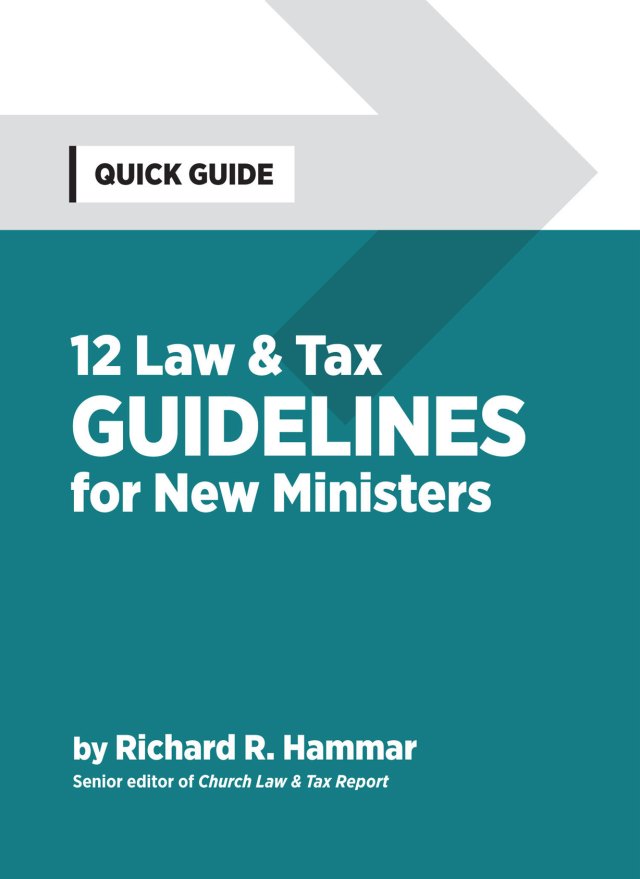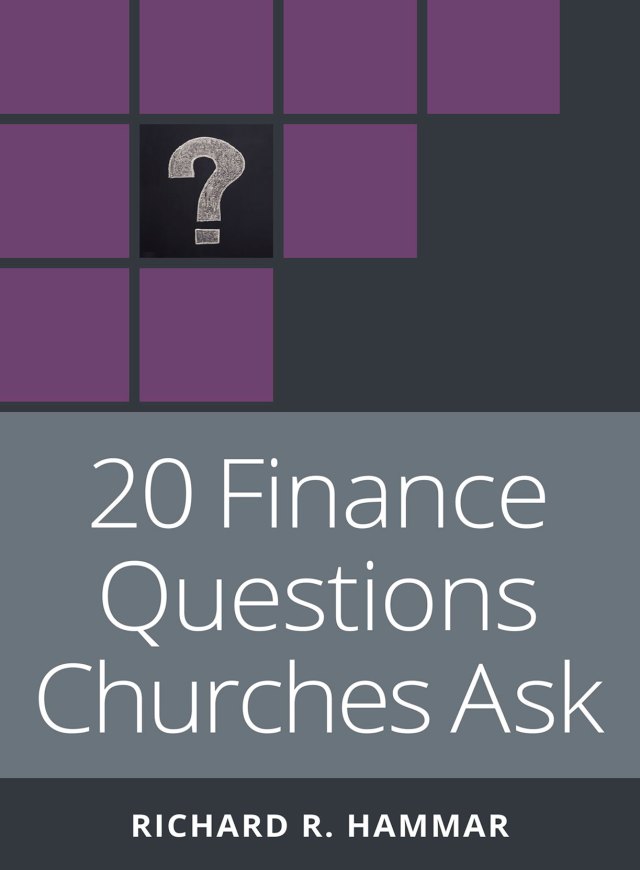In the past 20 years, I’ve addressed numerous financial developments of direct relevance to churches. Here are nine key changes that have significantly affected the way churches manage money:
1. Substantiating charitable contributions of cash
The Pension Protection Act of 2006 amended the tax code to require all cash contributions, regardless of amount, to be substantiated by either a bank record (such as a cancelled check) or a written communication from the charity receiving the donation, the donor’s name, the date of the contribution, and the amount of the contribution.
The recordkeeping requirements may not be satisfied by maintaining other reliable written records. In the past, donors could substantiate cash contributions of less than $250 with “other reliable written records showing the name of the donee, the date of the contribution, and the amount of the contribution” if no cancelled check or receipt was available. This is no longer allowed.
2. Intermediate sanctions
Section 501(c)(3) of the tax code exempts churches and most other religious organizations and public charities from federal income taxation. Five conditions must be met to qualify for exemption. One is that none of the organization’s assets “inures” to the private benefit of an individual other than as reasonable compensation for services. Churches and other tax-exempt organizations that pay unreasonable compensation to an employee are violating one of the requirements for exemption and are placing their exempt status in jeopardy. However, the IRS has been reluctant to revoke the tax-exempt status of charities that pay unreasonable compensation, since this remedy punishes the entire organization rather than the individuals who benefited from the transaction. For example, should a private university lose its tax-exempt status because of the excessive compensation it pays to its head football coach?
For many years the IRS asked Congress to provide a remedy other than outright revocation of exemption that it could use to combat excessive compensation paid by exempt organizations. In 1996, Congress responded by enacting section 4958 of the tax code. Section 4958 empowers the IRS to assess “intermediate sanctions” in the form of substantial excise taxes against insiders and their relatives (“disqualified persons”) who benefit from an “excess benefit transaction.”
Section 4958 also allows the IRS to assess excise taxes against a charity’s board members who approved an excess benefit transaction. This penalty can be up to 10 percent of the amount of any excess benefit paid to a disqualified person, up to a total of $20,000 with respect to any one transaction.
These excise taxes are called “intermediate sanctions” because they represent a remedy the IRS can apply short of revocation of a charity’s exempt status. While revocation of exempt status remains an option whenever a tax-exempt organization enters into an excess benefit transaction with a disqualified person, it is less likely that the IRS will pursue this remedy now that intermediate sanctions are available.
3. Automatic excess benefit transactions
In a series of four rulings, the IRS assessed intermediate sanctions against a pastor as a result of excess benefits paid to him and members of his family by his church. As noted in the previous section, intermediate sanctions are substantial excise taxes the IRS can impose on certain persons who receive excess benefits from a tax-exempt organization. The IRS concluded that a pastor’s personal use of church property (vehicles, cell phones, credit cards, etc.) and nonaccountable reimbursements (not supported by adequate documentation of business purpose) that a church pays its pastor are automatic excess benefits resulting in intermediate sanctions, regardless of the amount involved, unless they are reported as taxable income by the church on the pastor’s Form W-2 or by the pastor on Form 1040 for the year in which the benefits are provided.
This was a stunning interpretation of the tax code and regulations that directly affects the compensation practices of many churches and exposes some church staff members to intermediate sanctions.
4. IRS Audit Guidelines for Ministers
In 1995 the IRS released its first “audit guidelines” for ministers pursuant to its “Market Segment Specialization Program” (MSSP). The audit guidelines were intended to promote a higher degree of competence among IRS agents who audit ministers. In 2009, the IRS released a newly revised version of the guidelines (the Audit Technique Guide for Ministers) that address a number of important issues, and contain several examples. The audit guidelines instruct IRS agents in the examination of ministers’ tax returns. They alert agents to the key questions to ask, and provide background information along with the IRS position on a number of issues. It is therefore important for ministers and church treasurers to be familiar with these guidelines. The guidelines address, and clarify, the following issues:
Who qualifies for special tax treatment as a “minister?” The tax code contains several references to ministers, including eligibility for a housing allowance, self-employed status for Social Security, exemption from income tax withholding, and exemption from self-employment tax if several conditions are met. However, it is sometimes difficult to know if a particular church staff member is a “minister” subject to these rules. The audit guidelines address this question, and provide clarification.
Tax-free gift or taxable compensation. The guidelines inform IRS agents that “gifts given to a minister, other than retired ministers, may actually be compensation for services, hence includable in gross income” for tax purposes. The guidelines provide agents with assistance in deciding if a church’s payment to a minister is a tax-free gift or taxable compensation for services.
Retirement gifts. The audit guidelines clarify the tax treatment of retirement gifts made by churches to retiring clergy.
Housing allowance. The guidelines make several clarifications pertaining to the housing allowance:
First, the housing allowance is subject to self-employment tax. This is not a problem for ministers who own or rent their home, since they simply add the amount of their housing allowance exclusion to their earnings subject to the self-employment tax. But what about ministers who live in a church-provided parsonage? How much should they add to their earnings subject to the self-employment tax? This has been a difficult question for ministers living in parsonages, and there has been very little guidance from the IRS or the courts. The guidelines state: “If a church-owned parsonage is provided to the minister, instead of an allowance, the fair rental value of the housing must be determined. Determining the fair rental value is a question of all facts and circumstances based on the local market, but the church and minister have often already agreed on a figure and can provide documentary evidence.”
Key point. Presumably, this same language would apply in computing the fair rental value limit for ministers who own or rent their home.
Second, the guidelines confirm that the housing allowance “only applies if the employing church designates the amount of the allowance in advance of the tax year,” and that “the designation may appear in the minister’s employment contract, the church minutes, the church budget, or any other document indicating official action.”
Third, the guidelines provide agents with the following list of expenses that can be considered in computing the housing allowance: rent, house payments, furnishings, repairs, insurance, taxes, utilities, other expenses (including down payments, interest, etc. but not food or servants or entertainment).
Fourth, the guidelines acknowledge that even if a minister’s home mortgage interest and real estate taxes have been paid with money excluded from income as a housing allowance, he or she “may still claim itemized deductions for these items.” This is the so-called “double deduction,” and it is one reason why home ownership is attractive for ministers.
Business expenses. Ministers’ business expenses often are examined by the IRS in an audit, and so information in the guidelines on this topic is of special interest. The guidelines review the definition of an “accountable” reimbursement arrangement, and then summarize the tax treatment of several business expenses of ministers, including, transportation, travel, business use of a home, supplies and publications, and dues versus contributions.
Self-employment tax exemption. The guidelines review the requirements for exemption of ministers from self-employment tax.
Employee or self-employed for federal income tax purposes. The question of whether a minister is an employee or self-employed for federal income tax reporting purposes is a question that has vexed many ministers and church treasurers. The IRS audit guidelines do not say that all ministers are employees for federal income tax reporting purposes. This flexible approach leaves open the possibility that some ministers will not be employees under the applicable tests. Note, however, that self-employed status will be the exception, and that any minister reporting income taxes as self-employed must expect to have his or her status challenged if audited.
5. Clergy Housing Allowance Clarification Act of 2002
In 1971, the IRS issued a revenue ruling limiting the nontaxable portion of a church-designated housing allowance for ministers who own their homes to the annual “fair rental value” of the home (furnished, including utilities). However, in a 2000 case (Warren v. Commissioner), the Tax Court struck down the fair rental value test as an unwarranted interpretation of the tax law by the IRS.
The IRS appealed the Tax Court’s decision to the ninth circuit federal court of appeals in California, and the appeals court issued a preliminary ruling in 2002 ordering the parties (and a law professor) to submit briefs addressing the question of whether the housing allowance is an unconstitutional “establishment” of religion. The court’s order left little doubt that it considered the housing allowance to be unconstitutional. The court’s action was extraordinary, since neither party had ever raised the constitutionality of the housing allowance as an issue in the case.
In response to this threat to the housing allowance, the “Clergy Housing Allowance Clarification Act of 2002” was introduced in the House of Representatives. It was enacted by a vote of 408 to 0. The Senate unanimously enacted the same bill and President Bush signed it into law.
The Act was passed in order to force a dismissal of the Warren case and deprive the federal appeals court of the opportunity to address the constitutionality of the housing allowance on its own initiative.
6. Property tax exemptions
Another church finance development is the increasing number of lawsuits addressing the extent of the property tax exemption for church property. This increase in litigation is due in part to the difficulty in some cases of determining the exempt status of novel uses of church property, including fitness centers and coffee shops. But it is also attributable to the growing appetite by local governments for additional tax revenues to pay for their programs and services.
7. Nonqualified deferred compensation plans (section 409A of the tax code)
Congress added section 409A to the tax code in 2004 in response to public outrage over the Enron scandal. With reports of over $100 million in deferred compensation benefits being paid out to key executives in the months prior to the company’s collapse, the public demanded action. Section 409A imposes strict requirements on most nonqualified deferred compensation arrangements. If these requirements are not met, all compensation deferred under the plan for the taxable year and all preceding taxable years may be included in taxable income for the taxable year to the extent it is not subject to a substantial risk of forfeiture and was not previously included in taxable income. Other penalties may apply, including an increased interest rate on underpayment of tax, and a 20 percent additional tax on the amount to be included in income.
In 2007 the IRS published final regulations interpreting section 409A. The final regulations define a “nonqualified deferred compensation plan” broadly to include any plan that provides for the deferral of compensation beyond the current year. This definition is broad enough to include many kinds of compensation arrangements, including severance agreements used by churches. Some exceptions apply. The takeaway point is this—church leaders should seek legal counsel before finalizing a severance agreement with an employee to avoid the imposition of penalties.
8. The Sarbanes-Oxley Act
In 2002 Congress enacted the Sarbanes-Oxley Act. The Act was designed to restore investor confidence in the financial markets by holding companies issuing stock to much higher standards. Most of the Act’s provisions are amendments to the two main federal securities laws, the Securities Act of 1933 and the Securities Exchange Act of 1934. Churches are specifically exempted from these laws except for the antifraud provisions, so they generally are not subject to most of the provisions of Sarbanes-Oxley.
A few provisions of the Act are not amendments to federal securities law but instead are amendments to federal criminal law. Since no blanket exemption for churches is granted under federal criminal law, they are subject to these provisions. One of these provisions amends federal criminal law to include the destruction or falsification of tax records as a criminal offense.
To illustrate, a pastor discovers in November of this year that the church board failed to designate a housing allowance for him. He creates a housing allowance that he dates “December 31, 2012,” which purports to designate a housing allowance for all of 2013. The church is not a public company and therefore is not subject to most of the provisions of the Sarbanes-Oxley Act. However, the Act makes it a crime to knowingly falsify any document with the intent to influence “the investigation or proper administration of any matter within the jurisdiction of any department or agency of the United States … or in relation to or contemplation of any such matter or case,” and this provision contains no exemption for churches or pastors. It is possible that the pastor’s falsification of the 2013 housing allowance violates this provision in the Sarbanes-Oxley Act, exposing him to a fine or imprisonment of up to 20 years.
9. The Affordable Care Act (“Obamacare”)
In 2010, Congress enacted the 2,500-page Patient Protection and Affordable Care Act in order to increase the number of Americans covered by health insurance and decrease the cost of health care. A number of the Act’s provisions affect churches, including the “play or pay” rules for larger churches having 50 or more employees, and the availability of a tax credit for smaller churches to assist them in paying for health insurance coverage for their employees.
There are efforts underway in Congress to substantially change, or delay, some of the Act’s provisions, but it is not possible at this time to know the outcome of these efforts. Substantial changes may occur, and they will be covered in future editions of this newsletter.





